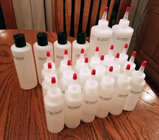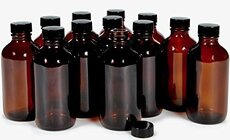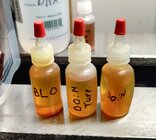You can also pull the outer child proof cover on the cap and make it easy open for all you old farts that need to get the grandchild to open for you.
I do this occasionally. Mostly though I simply grab the outside of the lid with suitable pliers, squeeze, and twist. Always works.
Go to a local independent pharmacy and ask them to buy a case for you of plastic 2oz, 3oz, 4oz, 6oz, or 8oz plastic liquid bottles like the kind cough syrup is dispensed. Inexpensive, UV light protected, and just right to keep the air out to prevent oxidation from occurring and you can get the size you want. Buy a big can and pour up in the small bottles.
You can get small plastic bottles from other sources too, such as Amazon. When the covid pandemic hit and hand sanitizer became unavailable to buy I bought 100s of plastic squeeze bottles from Amazon and made hand sanitizer to give out. (I had several gallons of isopropyl alcohol on hand and mixed up sanitizer. - When I posted this picture of one batch on another forum...

... an incredibly kind person saw it and shipped four metal 4-gallon cans of mixed sanitizer to me from his family company. I was floored. He wouldn't even accept shipping costs! I was able to bottle and distribute sanitizer to so many individuals, families, and organizations, such as churches that had food banks, charity organizations that help provide care and feed to single mothers, homeless - anyone who wanted some. We sent gallon bottles to some organizations. We still keep some small bottles in our cars. I also ran into another fellow who had a truckload of boxes of vinyl disposable gloves made for the food-handling industries - instead of trying to make a big profit he sold boxes or cases for what he paid for them! There are good people everywhere...
One problem with plastic bottles (especially as typically made from LDPE) holding finishes or other liquids - if stored for a long time, some of what's inside can evaporate through the plastic and the bottles will develop a vacuum and start distorting with the sides "caving" in. I have no idea what this might do to finishes. I also have bottles for when I bottle honey. Don't know if they are better but the plastic is a different type and thicker. The best plastic bottles I've seen come with excellent seals - those used by Mercury Adhesives for CA glue. The plastic is much thicker.
Another option is glass bottles. I've ordered cases of glass bottles with well-sealed caps, some for when I make vanilla extract, some I used for chemicals. Vapors cannot go through the glass. Glass can't be used for squeeze dispensing, but I think they are far better for storing chemicals, finishes, and other solutions over extended periods. (Visitors who cook love to take home a bottle of real vanilla extract made from Madagascar vanilla beans!)
I bought many bottles like this. I suspect the amber color could also minimize changes from light, but last time I checked I was still not an chemist or pharmacist. I do know they are good for long term storage of many types of liquids.

(Fun fact - helium can pass through glass! Before laser diodes and laser pointers were available the local geek squad (I and friends) bought Helium-Neon lasers in glass tubes and built power supplies to drive them. After extended time, some of the helium would escape due to it's tiny atomic size and the laser would quit lazing. The solution, put the laser tube in a chamber pressurized with helium. We didn't have that but it also worked to put the tube in the top of an inverted bucket and fill the bucket from the bottom with helium gas! Didn't take much.
There, more things that will probably not be interesting to more than 1 person in 10,000!

JKJ







